Learn more about Mexico
Priorities
- Promote the generation of information and knowledge taking into consideration gender as a crosscutting issue as well as the best interests of the child, with the aim of raising awareness on child labor, forced labor and trafficking in persons.
- Carry out comparable measurements through the available statistics on child labour, with the use of the Child Labor Risk Identification Model developed within the framework of the Regional Initiative Latin America and the Caribbean Free of Child Labour.
- Establish strategic partnerships to eradicate, child labour, forced labour and trafficking in persons in the context of migration.
- Strengthen the application of preventive actions in supply chains, such as the certification of work centers and the development of standard clauses in collective contracts, to reduce the risk of child labour, forced labour and trafficking in persons.
- Develop actions with a view to updating labour inspection protocols on child labor and trafficking in persons.
- Strengthen the capacity of public servants to detect, identify and provide attention to victims of child labor, forced labor and trafficking in persons.
- Improve coordination efforts at the federal, state and municipal level, promoting the creation of communication networks of the Inter-secretarial Commission for the Prevention and Eradication of Child Labor and Protection of Adolescents Workers of Legal Working Age in Mexico (CITI) and the Inter-Secretariat Commission to Prevent, Punish and Eradicate Crimes in the area of Trafficking in Persons and for the Protection and Assistance to Victims of these crimes.
- Promote the ratification of the ILO Protocol of 2014 to the Forced Labour Convention, 1930.
- Set up denunciation lines, anonymous and safe, for child labour, forced labor and trafficking in persons cases.
- Strengthen intersectoral and international cooperation for the development of strategies to eradicate child labour, forced labour and trafficking in persons.
Progress
- In February 2023, Mexico published the "Agreement that that sets forth the goods which importation is subject to regulation by the Ministry of Labor and Social Welfare." Since its entry into force, in May 2023, in collaboration with the Secretariat of Economy and the Secretariat of Finance and Public Credit, the Secretariat of Labor and Social Welfare began the implementation of a novel mechanism through which it will be possible to investigate goods produced in whole or in part by forced or compulsory labor, including forced or compulsory child labor. If If the investigation determines that certain goods were produced with forced or compulsory labor, there will be a resolution with the prohibition of the importation of those goods.
- In November 2022, the Mexican Senate approved the 2014 Protocol relating to ILO Convention 29 on Forced Labor. And on June 11, 2023, the Government of Mexico deposited the instrument of ratification of this Protocol within the framework of the 111th Meeting of the ILO Conference. This ratification commits the Mexican State to suppress forced labor and adopt effective measures to prevent and eliminate it. Its entry into force will be in June 2024.
- Strengthening of the inter-institutional collaboration, since Mexico became a Pathfinder Country in 2019; growing and continuous efforts to increase education, training, and awareness on issues of child labour, human trafficking and forced labour among the various government agencies.
- During 2022 and 2023, the Council of the National Observatory for the Prevention of the Recruitment of Children and Adolescents by Organized Crime (ONPRENNA) and the Inter-Ministerial Commission to Prevent, Punish, and Eradicate Crimes in the Field of Human Trafficking and for the Protection and Assistance of Victims of these Crimes, jointly coordinated the:
- 'Working Group on Judicialization for Integrated Attention to Human Trafficking’;
- 'Working Group for Technical Assistance in the Design of Public Policies and Legislative
- Harmonization’;
- 'Working Group for the Design and Dissemination of an Integrated Strategy for the Prevention of the Recruitment of Children and Adolescents’; and
- 'Working Group for the Prevention of Trafficking in Persons’.
- In December 2020, Mexico published and disseminated the National Survey of Child Labor 2019 (ENTI): This information will serve to implement appropriate actions and policies to address child labour problems. Likewise, the ENTI 2019 will allow continuing replicating and updating the Child Labour Risk Identification Model (MIRTI) at the municipal level, and thereby design policies and actions for the eradication of child labour.
- Mexico launched a National Network of Local Commissions (CITIs) to prevent and eradicate child labour and protect adolescent workers. The CITI focuses on strengthening and improving inter-institutional coordination at the federal, state, and municipal level, to create synergies and joint efforts to eradicate child labour in Mexico.
- Mexico fostered the linkage with civil society organizations and international organizations to strengthen ties of cooperation aimed at the eradication of child labour, human trafficking and forced labour.
- Development of the National Program on Trafficking in Persons responding to the need of prevention, protection and reparation of victims of human trafficking. This program will be the national public policy on the matter for the period 2020-2024;
- Enhanced coordination through the creation or strengthening of a number of working groups and inter-ministerial commissions. For example:
- Inter-secretariat Commission to Prevent, Punish and Eradicate Crimes in the Matter of Trafficking in Persons and for the Protection and Assistance to Victims of these Offenses.
- Inter-ministerial Commission for the Prevention and Eradication of Child Labour and Protection of Adolescent Workers of Legal Working Age in Mexico.
- National Network of Local Commissions for the Prevention and Eradication of Child Labour and the Protection of Working Adolescent of Legal Working Age.
- Working group to face the COVID19 health emergency and its impact on child labour and forced labour.
- Mexico also conducted a series of capacity-building activities on child labour issues.
- Awareness raising through the convening of the 12th National Drawing Contest on Child Labour entitled “Mexico without Child Labour”. The objective of this contest is to allow girls, boys and adolescents to express their opinion about child labour through art; it also seeks to create awareness among the general population on the risks of child labour;
- Strategic partnerships between the Federal Prosecution Office for the Protection of Girls, Boys and Adolescents and civil society organizations such as World Vision Mexico. This partnership seeks to train various public and private actors to tackle child labour. The Fields of Hope Program seeks to prevent and reduce child labour in the sugar cane and coffee sectors in the states of Veracruz and Oaxaca. This programme is implemented by World Vision and funded by the US Department of Labor.
- While Mexico as a pathfinder country has committed to a number of priorities to tackle child labour and forced labour, additional efforts have been directed towards Target 8.7. For example:
- Mexico was the first country in the region to implement Phase I and II of the Child Labour Risk Identification Model, through which it was possible to identify the municipalities with the highest probability of child labour in its 32 States.
- Mexico contributes to the development of a global research agenda on child labour and forced labour through their participation in the International Advisory Board of the MAP16 Project and the Project “From Research to Action: Using Knowledge to Accelerate Progress in the Elimination of Child Labor and Forced Labor”. The advisory board provides technical and strategic guidance to the conduct of child labour and forced labour research. It constitutes a platform for research cooperation and dialogue, which offers the opportunity to share Mexican experience in tackling child labour and forced labour;
- The National Institute of Statistics and Geography implemented the National Survey on Child Labour in 2019, in cooperation with the ILO which will allow assessing the prevalence of child labour in the country.
International Instruments
| Area | Ilo Instrument | Status | Ratification date | CEACR comments |
|---|---|---|---|---|
| Child Labour | C138 Ratification of C138 - Minimum Age Convention (1973) |
In Force | 10 Jun 2015 | |
| Child Labour, Forced Labour, Human Trafficking, Modern Slavery | C182 Worst Forms of Child Labour Convention (1999) |
In Force | 30 Jun 2000 | |
| Child Labour, Modern Slavery | C029 Forced Labour Convention (1930) |
In Force | 12 May 1934 | |
| Forced Labour, Human Trafficking, Modern Slavery | P029 Protocol of 2014 to the Forced Labour Convention (1930) |
In Force | 11 Jun 2023 | |
| Forced Labour, Modern Slavery | C105 Abolition of Forced Labour Convention (1957) |
In Force | 01 Jun 1959 | |
| Child Labour, Forced Labour, Human Trafficking, Modern Slavery | C143 Migrant Workers (Supplementary Provisions) Convention (1975) |
|||
| Child Labour, Forced Labour, Human Trafficking, Modern Slavery | C181 Private Employment Agencies Convention (1997) |
|||
| Freedom of Association | C087 Freedom of Association and Protection of the Right to Organise Convention (1948) |
In Force | 01 Apr 1950 | |
| Freedom of Association | C098 Right to Organise and Collective Bargaining Convention (1949) |
In Force | 23 Nov 2018 | |
| Discrimination | C100 Equal Remuneration Convention (1951) |
In Force | 23 Aug 1952 | |
| Discrimination | C111 Discrimination (Employment and Occupation) Convention (1958) |
In Force | 11 Sep 1961 | |
| Occupational Safety and Health | C155 Occupational Safety and Health Convention (1981) |
In Force | 01 Feb 1984 | |
| Occupational Safety and Health | C187 Promotional Framework for Occupational Safety and Health Convention (2006) |
| Area | UN Treaty | Signature date | Ratification date | Status |
|---|---|---|---|---|
| Child Labour | IV-11 Convention on the Rights of the Child (1989) |
26 Jan 1990 | 21 Sep 1990 | |
| Child Labour | IV-11-c Optional Protocol to the Convention on the Rights of the Child on the sale of children, child prostitution and child pornography (2000) |
7 Sep 2000 | 15 Mar 2002 | |
| Forced Labour, Human Trafficking | PALERMO_PROTOCOL Protocol to Prevent, Suppress and Punish Trafficking in Persons, especially Women and Children, supplementing the United Nations Convention against Transnational Organized Crime (2000) |
13 Dec 2000 | 4 Mar 2003 | |
| Human Trafficking, Modern Slavery | XVIII-4 Ratification of the Supplementary Convention on the Abolition and of Slavery, the Slave Trade and Institutions and Practices Similar to Slavery (1956) |
7 Sep 1956 | 30 Jun 1959 |
Sources: ILO Normlex & UN Treaty Collection
RESOURCES
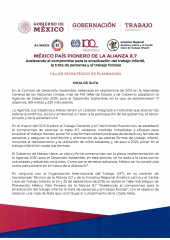
Mexico Strategic Workshop Report and Roadmap
Document
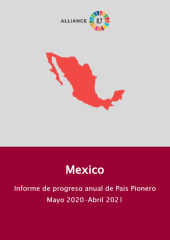
México - Informe de progreso anual de Pais Pionero, 2020-2021
Document
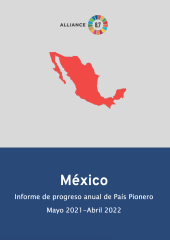
México - Informe de progreso anual de Pais Pionero, 2021-2022
Document

México - Informe de progreso anual de Pais Pionero, 2022-2023
Document
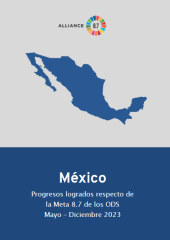
México - Informe de progreso anual de Pais Pionero, Mayo 2023 - Diciembre 2023
Document
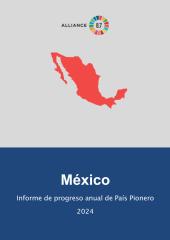
México - Informe de progreso anual de Pais Pionero, 2024
Document